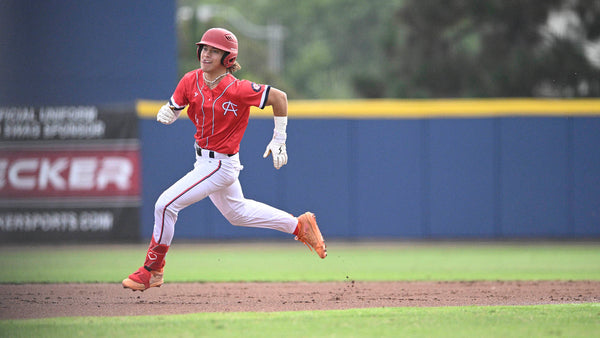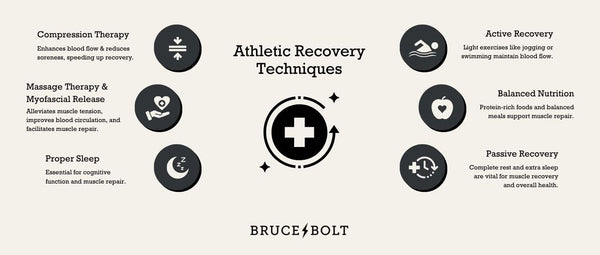Athletic recovery goes hand-in-hand with consistent athletic performance, and it extends beyond mere rest or hydration. It includes a comprehensive regimen of structured techniques and habits aimed at speeding up the body's natural healing process, boosting athletic performance, and reducing the chances of serious injuries.
It is no wonder why in the highly competitive and physically demanding world of sports, recovery has become an integral part of training schedules. In the context of baseball, recovery is critical since athletes require not only physical stamina but focused cognitive function for consistent play on the field.
Embracing a comprehensive athletic recovery regimen is more than a strategy; it’s a lifestyle that leads to peak physical performance and improved overall health. This article is designed to provide you with knowledge that will set you on a path that will elevate your training, enhance your performance, and ultimately, help you achieve your athletic goals.
Understanding Athletic Recovery
Athletic recovery is an umbrella term covering techniques, routines, and habits aimed at restoring your body to optimal functioning after undergoing rigorous physical activities or training sessions. It's not simply recuperating from an injury or illness but primarily concerns how elite athletes restore their energy reserves, repair any muscle/tissue damage, and maintain peak performance.

Don't Ignore the Signs of Physical Stress!
Physical stress, especially from intense exercise, can lead to muscle soreness and fatigue. It's the body's natural response, signaling a need for a break, essentially prompting a period of recovery. Ignoring these signs can escalate the extent of damage, lengthen recovery times, and in the long run, compromise your athletic performance.
Finding a Balance Between Training & Recovery
For a professional athlete, the balance between training intensity and recovery is essential. The more intense the exercise, the higher the need for a comprehensive recovery strategy. It's here that aspects like compression therapy, nutrition, and adequate sleep come into play, as they influence how quickly and effectively you can recover.
So, What is Athletic Recovery?
In summary, athletic recovery means allowing your muscles, nerves, bones, and connective tissues adequate time to heal. The human body has an innate capability to mend itself, but athletic recovery techniques can expedite this process. They help flush out lactic acid buildup, a common result of intense training, leading to a reduction in muscle soreness and a generally speedier recovery.
Stay tuned as we explore these techniques and their specific functions in the following section. By understanding and implementing them in your regimen, you'll enhance your body's natural recovery process, paving the way for improved athletic performance on the field.
Most Effective Athletic Recovery Techniques
Recovery is more than just taking a day off training. It's a systematic approach involving scientifically backed techniques that support and enhance your body's innate healing capabilities. Here are some of the most effective athletic recovery techniques often recommended by professionals.

Compression Therapy
Wearing compression sleeves improves blood flow to the muscles, helping to reduce muscle soreness and providing quicker recovery. They are particularly useful to athletes during both active recovery and physical activity. Read this blog to learn more about how compression sleeves can help your throwing arm recover by increasing blood flow.
Massage Therapy & Myofascial Release Therapy
Massage and myofascial release therapy help relieve muscle tension, promote muscle repair, and enhance muscle contractions. Regular therapy aids in breaking down knots in the muscles and increasing blood circulation, promoting overall muscle recovery.
Adequate Sleep and Sleep Hygiene
Sleep deprivation impacts an athlete's reaction time, cognitive function, and overall recovery. Maintaining good sleep hygiene, such as sticking to a regular sleeping schedule, ensures adequate amounts of rest which is vital for muscle repair and recovery.
Active Recovery
Activities like light jogging, swimming, or cycling on off-training days are part of active recovery. They help keep blood flowing, preventing stiffness and aiding in muscle recovery.
Nutrition
Consuming foods rich in protein boosts protein synthesis, vital for muscle repair and growth. Eating balanced meals and hydrating well helps replenish muscle glycogen which is depleted during intense training.
Passive Recovery and Sleep Extension
Sometimes, the best recovery technique is simply doing nothing. Passive recovery involves taking complete rest, allowing your body to heal naturally. The benefits of sleep extension (or getting more sleep than usual) plays an essential role in physiological functions related to muscle recovery and cognitive function. Avoiding sleep deprivation is crucial to your overall health, with the adverse effects extending beyond athletics.
Each of these techniques targets different aspects of the athlete's recovery and contributes significantly to athletic performance. In the absence of a well-rounded recovery strategy, athletes risk facing mental burnout, decreased performance, or even severe injuries.
Potential Adverse Effects of Neglecting Athletic Recovery

Neglecting athletic recovery poses tangible risks, both physical and mental. Professional athletes must understand that effort needs to be supplemented with rest. Consistently denying the body its required recuperation can gradually lead to adverse effects that can impede athletic performance and, in some cases, result in serious injuries. Here are some potential consequences of neglecting athletic recovery:
- Diminished Performance: Without proper recovery time, the body may fall short of the ability to give its best performance due to muscle fatigue. Without adequate rest, even the easiest of tasks may seem challenging.
- Testosterone Levels: Findings have suggested that consistent intense training without ample rest can negatively affect hormone production, including testosterone. This can have various repercussions including reduced muscle strength and slowed muscle recovery.
- Weakened Immune System: Overexertion without giving your body enough recovery time can weaken your immune system making the athlete more susceptible to infections and illnesses.
Choices made off the field are equally important as the choices made on the field. Ignoring recovery can lead to compromised sleep hygiene, and deficient cognitive function, with impacts reaching as far as taking the athlete out of their regular training or competition. Recovery techniques should be integrated into regular practice regimes for overall well-being and optimal athletic performance.
Importance of Athletic Recovery in Baseball
In baseball, the constant rotation between batting, sprinting, throwing, and fielding (often of high intensity) demands physical strength and agility. Thus, proper athletic recovery plays an essential role in sustaining a top-notch performance level while reducing the risk of injuries. Implementing effective recovery techniques is as crucial as honing their catching or batting skills for baseball athletes.
How BRUCE BOLT Can Help
At BRUCE BOLT, our premium arm sleeves and leg sleeves are effective tools designed with the athlete in mind. When worn, they create pressure on the limbs that enhances blood circulation, helping your muscles recover faster from fatigue. It also reduces muscle soreness and lactic acid build-up that often results from intense training – aligning precisely with your recovery strategy.
Unlock your highest potential by giving your body the recovery it deserves. With a solid commitment to recovery and the right equipment from BRUCE BOLT, you can attain all of your goals out on the diamond.

